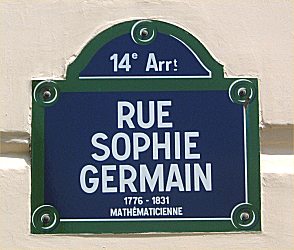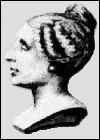Sophie Germain
April 1, 1776 - June 27, 1831
Written by Amanda Swift, Class of 1995 (Agnes Scott College)
Sophie Germain was born in an era of revolution. In the year of her birth, the American Revolution began. Thirteen years later the French Revolution began in her own country. In many ways Sophie embodied the spirit of revolution into which she was born. She was a middle class female who went against the wishes of her family and the social prejudices of the time to become a highly recognized mathematician. Like the member of a revolution, her life was full of perseverance and hard work. It took a long time for her to be recognized and appreciated for her contributions to the field of mathematics, but she did not give up. Even today, it is felt that she was never given as much credit as she was due for the contributions she made in number theory and mathematical physics because she was a woman.
Sophie Germain was born in Paris on April 1, 1776 to Ambroise-Francois and Marie Germain. Her family was quite wealthy. Her father was a merchant and later became a director of the Bank of France.
Sophie's interest in mathematics began during the French Revolution when she was 13 years old and confined to her home due to the danger caused by revolts in Paris. She spent a great deal of time in her father's library, and one day she ran across a book in which the legend of Archimedes' death was recounted. Legend has it that "during the invasion of his city by the Romans Archimedes was so engrossed in the study of a geometric figure in the sand that he failed to respond to the questioning of a Roman soldier. As a result he was speared to death" (Perl 64). This sparked Sophie's interest. If someone could be so engrossed in a problem as to ignore a soldier and then die for it, the subject must be interesting! Thus she began her study of mathematics.
Sophie began teaching herself mathematics using the books in her father's library. Her parents felt that her interest was inappropriate for a female (the common belief of the middle-class in the 19th century) and did all that they could to discourage her. She began studying at night to escape them, but they went to such measures as taking away her clothes once she was in bed and depriving her of heat and light to make her stay in her bed at night instead of studying. Sophie's parents' efforts failed. She would wrap herself in quilts and use candles she had hidden in order to study at night. Finally her parents realized that Sophie's passion for mathematics was "incurable," and they let her learn. Thus Sophie "spent the years of the Reign of Terror studying differential calculus" (Osen 85) without the aid of a tutor!
In 1794, when Sophie was 18, the Ecole Polytechnique was founded in Paris. It was an academy founded to "train mathematicians and scientists for the country" (Perl 64). Women were not allowed to enroll in the academy, but Sophie was able to obtain the lecture notes for several of the courses and study from them. This gave her the opportunity to learn from many of the prominent mathematicians of the day. Sophie was particularly interested in the teachings of J. L. Lagrange. Under the pseudonym of M. LeBlanc ( a former student of Lagrange's), Sophie submitted a paper on analysis to Lagrange at the end of the term. He was quite impressed with the work and wanted to meet the student who had written it. Lagrange was amazed that the author of the work was actually a female, but he recognized her abilities and became her mentor. With a male to introduce her, Sophie could enter the circle of scientists and mathematicians that she never before could. Up until this point not only had her gender been a hindrance to her, but her social status had been too. It was socially acceptable for aristocratic women to be taught the sciences and mathematics so that they could talk about it casually with friends. Sophie was of the middle class so this opportunity had passed her by.
In 1804, Sophie began corresponding with the German mathematician, Carl Friedrich Gauss. She was intrigued with his work in number theory and sent him some of the results of her work in number theory. Again she used her pseudonym to disguise her true identity. It was not until 1807 that he found out who M. LeBlanc truly was. He was thrilled to find that his "pen pal" was a very gifted woman. In 1808 Germain sent Gauss a letter describing some of her work in number theory. Sophie never heard from him about her last correspondence because he had stopped his work in number theory after taking a job as professor of astronomy at the University of Gottingen. About 12 years later, however, she wrote to the mathematician Legendre about what would be her most important work in number theory. "Germain proved that if x, y, and z are integers and if x5 + y5 = z5 then either x, y, or z must be divisible by 5. Germain's theorem is a major step toward proving Fermat's last theorem for the case where n equals 5" (Dalmedico 119). Fermat's last theorem says that if x, y, z, and n are integers then xn + yn = zn cannot be solved for any n greater than 2.
Gauss had guided Sophie's research, so now she began to search for a new mentor. At about this time the French Academy of Sciences announced a contest to explain the "underlying mathematical law" of a German physicist's study on the vibration of elastic surfaces. Sophie was fascinated and set out to explain the law underlying Chladni's study. The Academy set a two year deadline, and in 1811 Sophie submitted the only entry in the contest. Her lack of formal education was evident in the anonymous paper she submitted, and thus she was not awarded the prize. She still had much to learn in the area. Lagrange was able to correct her errors and two years later she again entered the contest which had been extended. She received honorable mention this time. Finally in 1816, she entered the contest for the third time and won with her paper Memoir on the Vibrations of Elastic Plates. Upon earning the prize, the judges did relate that there were some serious shortcomings in her explanation. These shortcomings would not be corrected for decades. After winning the contest, Sophie continued her work on the theory of elasticity publishing several more memoirs. [For example, see Recherches sur la théorie des surfaces élastiques (The Theory of Elastic Surfaces), published in 1821] The most important of these deals with the "nature, bounds, and extent of elastic surfaces" (Osen 90). Her work in the theory of elasticity would prove to be very important to the field.
The prize from the Academy, however, was of immediate importance because it introduced her into the ranks of the prominent mathematicians of the time. She became the first woman who was not a wife of a member to attend the Academy of Sciences' sessions with the help of Jean-Baptiste-Joseph Fourier. She was praised by the Institut de France and was invited to attend their sessions. This was "the highest honor that this famous body ever conferred on a woman" (Osen 90). Sophie worked with a well-known male mathematician in the 1820s as an "equal collaborator" (Dalmedico 122) to refine her proofs and work in number theory.
Sophie Germain died at the age of 55, on June 27, 1831, after a battle with breast cancer. Shortly before this Gauss, one of her earliest mentors, had convinced the University of Gottingen to give Sophie an honorary degree. She died before she could receive it.
Sophie Germain was a revolutionary. She battled against the social prejudices of the era and a lack of formal training in order to become a celebrated mathematician. She is best known for her work in number theory, but her work in the theory of elasticity is also very important to mathematics.
April 1995, revised July 1997 and July 2001.
Additional material by Larry Riddle
Sophie Germain and Fermat's Last Theorem
Sophie Germain made several important contributions to the investigation of Fermat's Last Theorem. Read about them in this essay (revised, July 21, 2009).Rue Sophie Germain

Credit: Cheryl Slaughter. Used with permission
Sophie Germain has been honored in several ways since her death in 1831. The street Rue Sophie Germain in Paris has been named in her honor and a statue of her now stands in the courtyard of the Ecole Sophie Germain, also in Paris. The house at 13 rue de Savoie in which she died has been designated as a historical landmark. The Sophie Germain Hotel is located at 12 Rue Sophie Germain.
Click here to see a map of the location of Rue Sophie Germain and a view of the street.
References
- Gray, Mary W. "Sophie Germain," in Women of Mathematics, A
Biobibliographic Sourcebook, Louise S. Grinstein and Paul J.
Campbell, editors, Greenwood Press, 1987.
This article contains an excellent bibliography of works written about Sophie Germain. - Gray, Mary W. "Sophie Germain, A Bicentennial Appreciation," AWM Newsletter, Vol. 6, No. 6 (1976), 10-14. [Reprint in Complexities: Women in Mathematics, Bettye Anne Case and Anne Leggett, Editors, Princeton University Press (2005), 68-74.]
- Franklin, Christine Ladd. "Sophie Germain: An Unknown Mathematicians," Century, Vol. 48 (1894), 946-949, [Reprinted in the AWM Newsletter, Vol. 11, No. 3 (1981), 7-11.]
- Dalmedico, Amy Dahan. "Sophie Germain." Scientific American Dec. 1991: 117-122.
- Osen, Lynn M. Women in Mathematics. Cambridge: The MIT Press, 1992.
- Perl, Teri. Math Equals: Biographies of Women Mathematicians + Related Activities. Menlo Park: Addison-Wesley Publishing, 1978.
- Smith Sanderson and Greer Lleaud. "Sophie Germain," Notable Women in Mathematics: A Biographical Dictionary, Charlene Morrow and Teri Perl, Editors, Greenwood Press, 1998, 62-66.
- Dubner, H. "Large Sophie Germain Primes." Math. Comput. 65, 393-396, 1996.
- Weisstein, Eric W. Sophie Germain Prime, http://mathworld.wolfram.com/SophieGermainPrime.html
- Biography at the MacTutor History of Mathematics Archive
- Edwards, Harold M. Fermat's Last Theorem, Springer, New York, 1977, 61-65.
- Petrovich, Vesna Crnjanski. "Women and the Paris Academy of Sciences," Eighteenth-Century Studies, Vol. 32, No. 3, Constructions of Femininity (Spring, 1999), 383-390. [Available at JSTOR (subscription required)]
- Math's Hidden Woman, http://www.pbs.org/wgbh/nova/proof/germain.html, from the Nova web site on its production of "The Proof".
- MathSciNet [subscription required]
- Author Profile at zbMath

